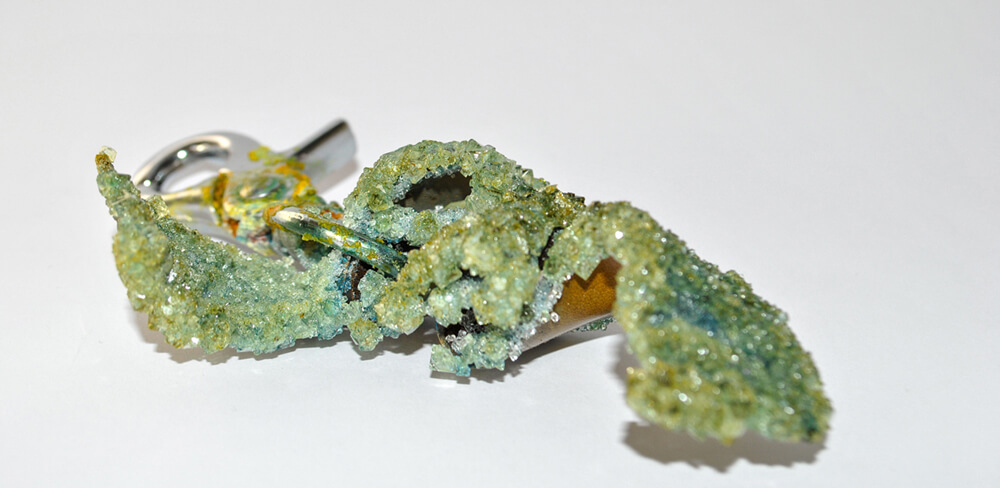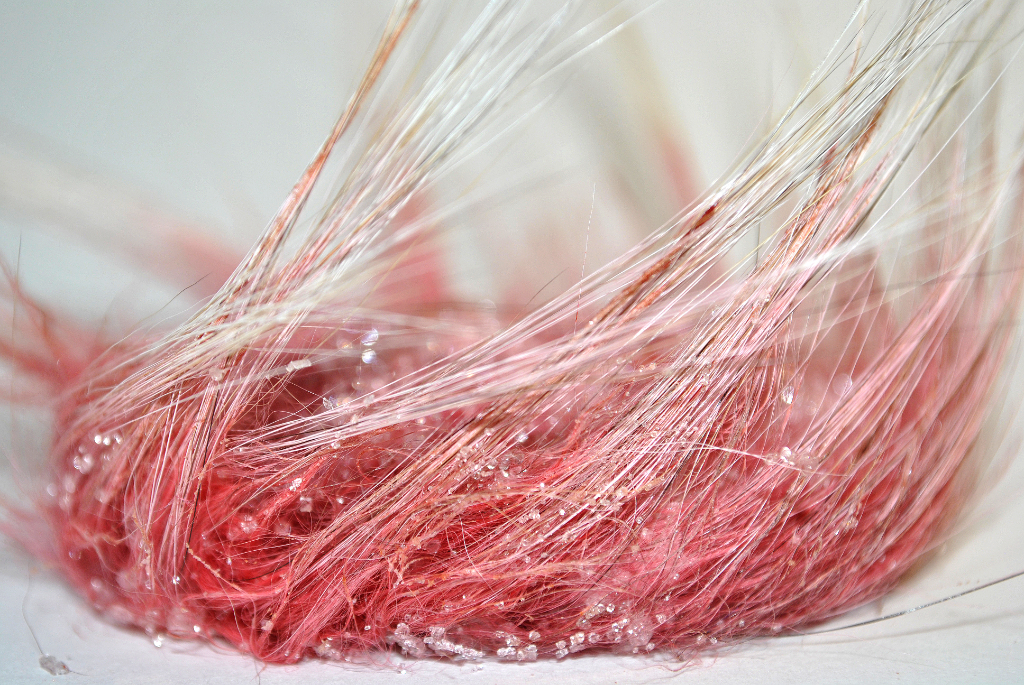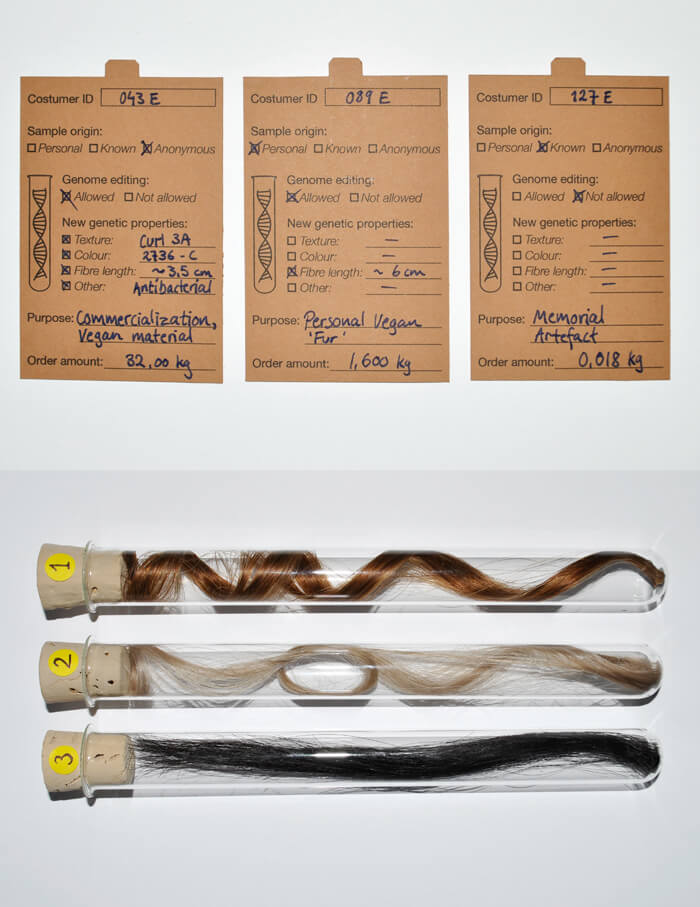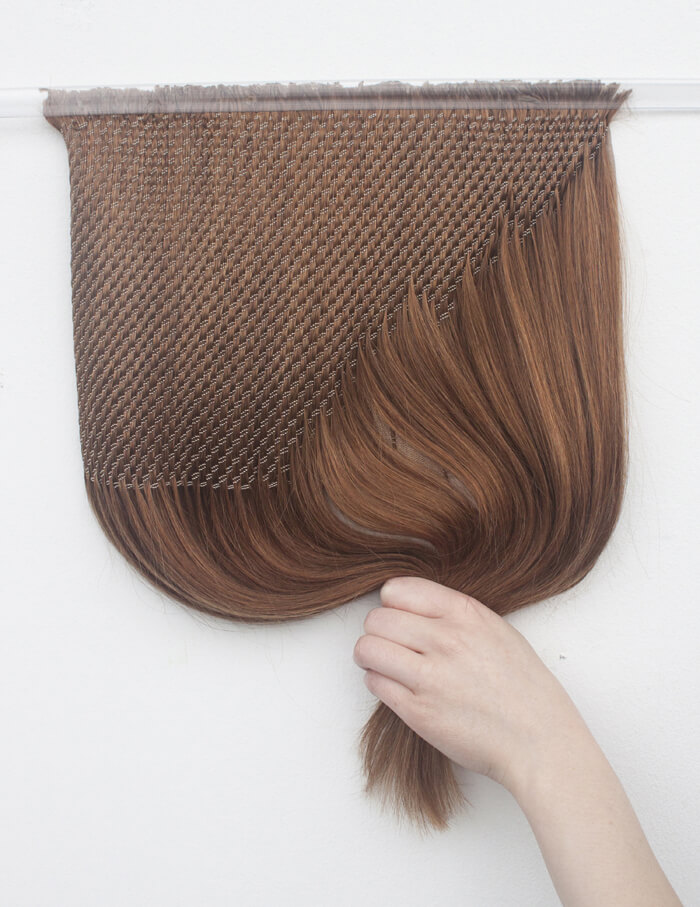Interview by Tina Gorjanc

Over the last couple of years, the fashion and textile industry has taken a great interest in the new possibilities that the biotechnology industry is opening up with its inventions. The ability to alter something so basic as a molecular structure of a material has enabled our imagination to persuade the production of laboratory-grown meat, leather and now fur. Speculative and critical design is getting a momentum within more commonly known branches of design enabling creatives to shift their interest away from just producing products to the desire to provoke questions and generate a debate around the ethics of the implementation of such technologies.
The approach is also reflected in the work of Christina Haxholm, a recent graduate from the LCFs’ Fashion Futures Course and author of the In-vitro Fur project. It is an artistic exploration of technological innovation that aims to challenge the ethical frameworks of our society. The 3D visualisation of the potential outcomes deriving from the merger of the fur industry and the bioengineering laboratory reflects the designers’ opinion on the promises and aspirations commonly presented to the public by scientists and synthetic biologists. She, therefore, advocates that in relation to new materials, technological innovation should be democratic and the ethics evaluated more often.
As a further exploration of the same topic, Haxholm developed her more recent Master’s Degree work Regenesis of Fur. The project is exploring ideological forecasts for the future of synthetic biology within the fashion industry. The 3 speculative design artefacts created by the designer are based on a set of 3 personas and therefore represent 3 different ideologies, and belief systems tackling the question: what it means to be ‘natural’?
The Future Vegan & The Genome Boutique, the first speculative artefact, caters to the future vegan community. In contrast, the second fictional product, called The Future Sensorial Explorer & The Specimens of New Nature, speaks to a future community that allures via aesthetic, sensory and emotional experiences. This future community believes that their subjective experiences of the world can validly inform their opinion.
The Future Scientist and The Patent of Synthetic Natures, the last identified personas’ group towards whom the project is directed, is a community that connects with nature through understanding physical and chemical laws rather than omniscient intervention. The debate-initiating question proposed by the designer to this group is, Does the technological development of synthetic biology foster more biodiversity and sustainable production, or is it just another way for humans to continue endless consumption and sustain the status quo of economics?
Questioning ethics and provoking shifts in mindset seems to be a rising new interest of emerging fashion-oriented creatives that, rather than look at the industry as a purely commercial field of practice, see the potential of utilising it as a platform that can deliver their research provocation to a vaster amount of people. This new discipline is blooming with futurist products and artefacts that can generate cultural discussion and, indeed, somehow steer the direction in which our technology is going to a great degree.



For those unfamiliar with your background, could you tell us a bit about it? How and when did the interest in biomaterials come out?
I’ve wanted to be a fashion designer since I was a kid, and I did my BA in Fashion Design at the Design School Kolding in Denmark. I wanted to use design to create meaning, and I was (and still am) fascinated with fashion’s ability to communicate, question and riot – but simultaneously, horrified by the toxic reality of the business, such as environmental damage and modern slavery.
So I got really interested in sustainability. I’ve spent years understanding and working with different concepts and ideas of what is important when it comes to sustainability, like circular economy, fair trade, material production and such. I have arrived at a point where I think that better understanding and being in a symbiotic relationship with the biological World will have a massive impact on our future on this Planet. The other areas are obviously still massively important and are still woven into my practice, but at this point in time, Biodesign has become a focus point for me.
When I did the MA Fashion Futures course at LCF, I learned about different perspectives on fashion, how to use speculative design as a communication tool, research social and scientific subjects, and develop futurist thinking. This approach, mixed with my interest in the teachings of the natural world, resulted in me experimenting with, questioning, evaluating and discussing biomaterials.
It started as an interest in bio-based or degradable textiles. It developed into a passion for everything concerning useful bacteria, synthetic biology, genetic modification, how these things can manifest as physical materials, and how they will affect our biodiversity, environment and society.
What are your aims as a fashion designer and material researcher?
At the most basic level, I hope to work towards a fashion industry that is beneficial or at least not harmful to people and the planet. Materials are interesting to me because much of what we do in fashion revolves around them – from design, raw material collection, production, and end-use. How we work with materials impacts the environment, the makers, and the user.
Some materials require toxic production processes – others are completely biodegradable. Some materials are super comfortable, and we use them for longer. Some materials start to challenge our habits and beliefs, like accepting gradual biodegradation in your home as a part of a product lifecycle (like food) or questioning if we are playing god by creating them (like lab-grown animal materials).
Sometimes the digital world creates sensory and almost tactile experiences that question in which ways we actually need physical materials. So I aim to understand better, explore the consequences and benefits of these material choices, and enable brands and people to push towards a healthier fashion industry.
Your graduation project, Regenesis of Fur, is born from creating in-vitro-grown fur and ‘exploring bioethical frameworks in relation to bioengineered materials’’. What is the intellectual process behind this project?
In Denmark, my home country, the fur industry is quite big, and as a designer in the making, I was introduced to fur many times. As a material, fur is incredibly useful and beautiful, but obviously, there are major ethical issues with its production of it. I started to notice and follow the developments of lab-grown meat, and the idea of lab-grown fur results from that.
When I decided to focus on this subject for my final project, I researched the existing methods of lab-grown animal materials like leather and spider silk, thinking that I might be able to grow an early version of fur. The process of creating lab-grown animal materials often involves manmade DNA and genetically modified yeast, which will produce the proteins in question.
But as the research phase progressed, my work focused on the many questions surrounding this technology. What will it mean to have vegan ideals in the future of lab-grown animal materials? Does DNA equal ownership or origin, and how does man-made DNA fit into that? Which measures will businesses take to influence us consumers and citizens in certain directions that could benefit them financially? And is this really a sustainable solution when it enables humans to consume at the same high level as we have until this point?
As you can hear, there are plenty of interesting discussions to be had, and I don’t believe our interaction with this technology should be left to scientific ethics boards or the funding of silicon valley. I think all of we could discuss them. So, I decided not to try to be a biologist and focus on what I do well; speculative design.
I call myself a futurist and designer; to live up to that, I have to enter any exploration with a mind ready to be disrupted. I design to ask questions and to creatively curate discussions that can lead to actions towards our most desired futures. When that facilitation is successful, it almost becomes creative politics – a platform for public imagination.
The concept of futurism is inherently abstract, and the point of futurism is not to predict or create the future but to enable people to create their own. Speculative design is a tool for futurism. I love how Stuart Candy puts it: Our collective ability to realise a positive future depends on our collective ability to imagine it. The Regenesis of Fur project identifies ideological forecasts for the future of synthetic biology and materials for fashion. It explores current bioethical ideologies and ways of identifying, projecting and challenging the values we employ.
I identified 3 personas, each representing their own ideologies, bioethical belief systems, and the idea of what it means to be or act ‘natural’. They are called: The Future Scientist, The Future Vegan, and The Future Sensorial Explorer. You might be able to identify with them. Based on these personas, I created a set of 3 speculative design artefacts, which act as a facilitator for the conversation, that could help us to navigate the future use of these exciting materials and technology.
What directions do you see taking your work into?
For a long time, I thought I would work as a designer in a fashion brand working with sustainability. Still, after the MA, I’ve become more interested in trend forecasting – not so much trends as in colour and shapes, but the social trends that influence how we live our lives.
My degree in futurism has given me the skills to identify and articulate trends and create visual and tangible futures from them. As a designer, I can align myself with ideas or concepts and expand them, especially in collaboration with people from other professions. I plan to work with trend, strategic and conceptual developments because it allows me to help brands and their customers make choices towards a sustainable future.
What is your chief enemy of creativity?
I tend to get caught up in every detail, thinking that every aspect has to be totally thought through, meaningful, revolutionary and innovative, or else it’s not worth doing. Appreciating mistakes and learning through trial and error is so important, but that’s easy to forget in a highly polished and competitive World. My way out is to collaborate. It removes some of the unhelpful pressure and gives way to amazing questions, discussions and editing. That really enables my creativity.
One for the road… What are you unafraid of?
I am completely unafraid of asking questions I don’t know how to answer and starting discussions I don’t know how to finish. I’ve become relatively comfortable with not knowing what I’m doing for a long time, as long as it’s exciting and meaningful.
Being willing to explore and challenge your reality, hopes, and fears, and maybe, especially, your bias, is great for developing well-founded and meaningful interactions. It’s definitely not always easy to act like that because challenging your belief system is hard and annoying.
But I’ve found that speculative design and futurism can create a frame in which it’s much easier. Maybe because I know I can leave it if it gets uncomfortable. But most of the time, it’s a very exciting space.





